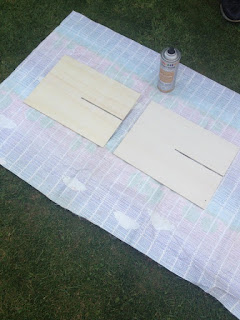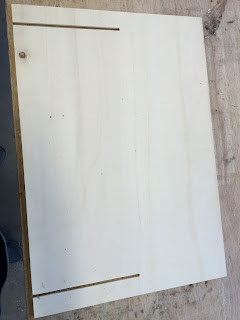Several small user tests were conducted during
the design and development phase. These tests were used to make a decision on
the sides were the sleeve for the planks should be, the connection methods used
for holding the basket together and the esthetics. Several designs were shown
to both a teenage girl and an adult woman and this resulted in the final green
and white checkered pattern used for the textile. The choice of connection
methods was discussed with several adults, keeping in mind both ease-of-use and
the production method. Buttons were chosen because they were already
implemented in the design and required less precise actions to fasten and
loosen the corners of the basket compared to zippers and proved to be more
secure than Velcro. Finally, the position of the sleeves was changed from
outside the basket to inside the basket because then they are more visible when
the basket is folded open in order to construct the table. This was confirmed
by several people, from teenagers to elderly people, testing several prototype
evolutions.
The two main user tests that were conducted
used two different test individuals with different foreknowledge. During the
first test, a student who had never seen the basket nor the table was asked to
convert the correctly build basket into ‘a
pick-nick table’. During the second test, an adult woman was asked to
convert the correctly build table into the pick nick basket. She had already
seen the final design of the basket and thus knew what the end result should
look like.
1.
1. Basket
to table without foreknowledge
The first thing that the test person does is
putting the handles next to the basket in order to get a clear view on the
whole product. She also immediately unbuttons the straps keeping the basket
upright, but does not unbutton the handles because they are not under any
tension and do not obstruct any movement. Next, she slides out the side panels
from the sleeves.
With both side panels removed, she starts
building the table legs with the basket lid. At first, she is restrained by the
force necessary to slide both sides in the lid grooves, but after a few
moments, she feels confident enough to use more force. However, she never pushes
the sides fully into the groves, resulting in a rather unstable bottom piece.
After interviewing the test person, she said she thought she might break the
parts. When the legs were constructed, she untied the knot of the cord holding
the bottom of the basket in place. After noticing the holes in this part, she
placed them on the table legs, aligned with the pins of the legs. Due to the
instability of the whole, she checked under the plank and noticed two small
pieces of wood and placed the table legs between them.
Because the test person had taken the bottom
plank out of the textile, she went looking for an opening for the remaining
planks. After discovering the zippers, she took the planks out and put them on
the legs, again aligning the holes in the planks with the pins on the legs. Because
of the rather unstable legs, these planks were unstable as well. She was
however able to put the textile on the table without the planks falling off.
It is clear that she was able to construct the
table, but by removing the planks from the textile, the fit between the holes
in the planks and the pins was too wide resulting in an unstable product. When
explaining the actual construction method, it soon became clear that improving
the fixture of the bottom plank in the textile together with coloring the pins
and indicating the position of the holes in the planks on the textile itself in
this same color, the misunderstandings of taking out all the planks would be
solved and the use of the pins on the legs would be more clear.
The
final result after correct assembly.
2. 2. Table
to basket with foreknowledge about the appearance of the final result
The test person immediately removes the textile
with the planks forming the table surface from the legs and starts
disassembling the legs. Just as with the previous test person, the friction
force with which the planks are kept together slow down the test person. After
trying three different ways to push or pull the planks away from each other,
more force was applied and the side planks could be disconnected from the
basket lid.
Because the table surface is still lying with
the bottom on the floor, the sleeves are visible and the test person slides
both planks in the sleeves. It is important to note that both were inserted
with the thin side first, making the pins remain visible at the sleeve opening.
After consulting the test person, it appeared that this was a deliberate choice.
When all planks were in place, the test person had put one side upright and
started pulling the next one up and pulling both sides together using the
textile that was in between them. This allowed the test person to easily keep
both sides up.
With both sides up, it was clear that the
straps needed to be used to fix the position of the planks. The test person
used one hand to keep the redundant textile away from between the sides and
used her other hand to attach the strap to the button. This was done for all
four corners in exactly the same way.
The construction of the basket was completed
much faster than the construction of the table and it can be assumed that the
reason for this is that the second test person did know what the basket needed
to look like. No extra instructions were needed to make sure the basket was
constructed correctly. Also, it is important to remark that for the
construction of this basket, the test person didn’t even notice the presence of
the zippers or the cord keeping the bottom plank in place, which means the
order of actions needed was clear and no research of the user was needed to get
to the next step in constructing the product.
The
final result after correct assembly.





















































